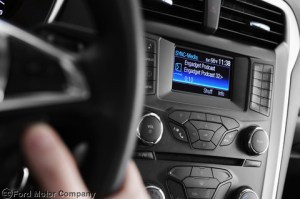In Car Entertainment (ICE) comes in many shapes and sizes. Gone are the days when all the ICE you have is simply a radio with a cassette or CD player. The automotive industry are desperate to keep up with the needs of the tech savvy consumers and are piling huge investments into the area to ensure they keep pace with the electronics markets.
As part of our Consumer Electronics Show (CES) series we are going to look at the current and future technology that will keep us entertained in our cars over the next decade. The Consumer Electronics Association, who organise CES has forecasted an 11% growth (to £5.4 billion) in the market for factory-installed technology equipment extras in cars.
Before we look at the new technology that we can expect to enjoy in our cars it is probably good to look back 10 years and understand how the market has developed and evolved.
Most cars were finally getting electric windows and mirrors, CD changers were now common place and cassette players were being quickly phased out. The lucky few also had highly sought after technology such as Satellite Navigation, touch screen TVs and iPod connections.
Fast forward 10 years and you find that much of this technology is now common place in many vehicles as standard and nearly all cars offer the option of having a built in Sat Nav or entertainment system.
Now we move onto the really interesting bit. Welcome to the future, well the near future of technology anyway!
Software Apps

Apps, the buzz word of the tech world since 2010 has finally made its way into motor vehicles. Most people instantly think of smartphones when they think of apps, and many vehicles will use smartphones to power their apps, but manufacturers have also decided that these apps need to be more integrated into their vehicles.
Manufacturers such as Ford and GM have laid out plans for their cars to fully integrate apps that will be carried and powered by smartphones, but displayed through in car screens. Products like the Ford SYNC Applink will allow developers to have their apps sat in the prime position for the drivers and passengers.
Allowing developers to create software that will be used directly by people when driving should help to increase innovation. While the car companies will have ultimate control over which apps can be used on these systems (sorry, not many games will be approved to run over the system!), providing a new platform for the apps to be delivered through will create a whole new environment for motoring apps.
So what can we expect to see? So far Ford have announced Glympse which will use the Ford SYNC tool to allow the user to share their location simply by voice command. The future is likely to see apps that allow people to set a meeting point and let the sat nav guide you there, find local entertainment (think the nearest cinema with full screen listing times), update you on the latest sport scores or give you up-to-the-minute news and weather. The apps will simply be limited by the innovation of the developer and strict safety requirements set by the manufacturer.
If you want to read more about this Liz Gannes has written a great article here.
Industry Expert Opinion – www.mp3car.com – Stephen Jensen
For some time at mp3Car, we’ve been searching for a way to get developers to collaborate and create apps suited to in-vehcile infotainment. The limiting factor always seemed to be hardware. How do we get something that will work well on a Honda, Land Rover, BMW, Lexus, etc all at the same time? Each manufacturer has their own engineering team and their own standards. This common platform is really what has been required to get a large enough user base for app development to flourish… until the revelation of the modern-day smartphone that is.
Initially, phones were meant simply for communicating verbally with others. Now it seems we can accomplish 80% of our full-blown desktop tasks on a smartphone. Born is the common hardware platform for the car. Now it seems it’s just up to the car manufacturers how much of this functionality they will make available through OEM entertainment systems. Or consumers can go to aftermarket solutions for integrating smartphones into their driving experience. Or consumers can simply just use their smartphone (hopefully safely) in the vehicle without integration with the vehicle. Mobile hotspot, infotainment system, software apps, voice recognition, music, video, all in that hot little device in your pocket.
In Car Wi-Fi / 4G Hotspots

Imagine you are taking your family on a longer car journey. The likelihood is that your children will all have devices that they want to connect to the internet (MP3 players, phones, tablets, handheld game devices). Instead of each of them struggling to use 3G, if the device is even able to use it, they are all able to simply connect to the cars hotspot and get broadband speeds for the whole journey.
Well the scenario above is about to happen. At CES BMW have already shown off their in car hotspot that will be available in the near future. Keeping the family connected to the internet may well keep them happy and remove the age old cries of “are we nearly there yet”!
Of course this technology has limitations at the moment. Not all areas are connected to either Wi-Fi hotspots or 4G. In the UK, 4G is likely to grow very quickly with the demand for fast internet becoming greater and greater. in the next few years, expect many car manufacturers to follow suit and provide a car-wide hotspot for passengers.
Voice Recognition Tools
This is something that is already available in some cars, but the difference will be how well the tools work. Most voice recognition software allows you to change your music choice or call a person using a connected phone. But it will not be long until you can dictate emails, text messages, notes and reminders while driving your car.
BMW is already in advanced development stages of such products. They use data centers to convert dictated text into actual written formats. This allows drivers to make instant notes without risking safety by removing their hands from the wheel.
This is likely to only be the start as well. With phone makers already pushing hard to make virtual assistants such as Apple’s ‘Siri’ and ‘Google Now’ these are likely to be added seamlessly into your vehicle.
With these services also learning how you live life it is very possible that as soon as you enter your car your likely destination will be highlighted, with traffic and time estimations provided. Your daily itinerary will be displayed with reminders about an important meeting or email you need to write. When driving along you will be updated with all the latest sport news before being automatically directed around the heavy traffic caused by an accident on your usual route to work.
Google aims to provide you with the information you need before you even ask. Voice commands and responses are likely to be vital to make these services truly interactive.
Wireless in Car Chargers
Ok this isn’t strictly entertainment, but having the ability to just place your phone on a mat in the car and start charging is pretty cool. The technology is known as Qi (pronounced ‘chee’) and works by transmitting energy over a magnetic field.
With all the new apps and technology that phones will be powering in cars it will be vital to keep the battery topped up and having a mat that will charge all phones that contain the technology.
Not all phones are currently equipped with it Qi, but it is becoming a popular feature with wider adoption of mainstream phones expected. Even though the technology isn’t used by phone manufacturers such as Apple, Toyota have already added Qi charging to their technology pack.
Tablet Computers
These are really not for the driver but passengers are now being provided with more and more opportunities to use tablets in their vehicles. With the internet slowly becoming available in cars this is a trend that is likely to continue.
Custom installs have been adding Tablets computers such as the iPad to backs of seats so the rear passengers can enjoy a wide variety of entertainment while being driven around.
Some manufacturers have now taken this one step further and are offering this as an optional extra. Range Rovers now can be equipped with a rear seat entertainment system provided by WhiteFire™, this system includes a touch controlled screen and headphones.
It will surely not be too long before family cars decide this is one of the best ways to keep the kids entertained in the rear seats. Although this technology will be great fun for the passengers the biggest issue is the speed that the technology develops. Keeping the systems up-to-date and able to offer all of the latest apps and content will become an issue.
Therefore it might actually mean that the manufacturers start producing casings and mountings that can be used while in the car but are also dismountable so the tablets can be used for everyday life as well.
Music

Last, but certainly not least are the developments in the music industry to ensure drivers can have the music they want when they want it. Radio stations and music have been the main source of entertainment in vehicles since the first stereo was ever added to a vehicle. The difference now is that the radio stations and music are digital and allowing a wider range and choice.
Pandora, iHeartAuto, TuneIn and Slacker are all popular radio streaming services in the US. The US has certainly embraced this type of technology far quicker than the UK. The head units and Infotainment systems now in development are incorporating this streaming technology, and when these products filter through to the UK the demand for the services is likely to grow.
Music is probably the most understated part of entertainment available to drivers but it looks set to continue to be the focal point of all entertainment systems. The question is will streaming services like this be enough, or will people want more on-demand services like Spotify?
Infotainment Systems
Infotainment systems are the current must-have for anyone that loves technology and cars. Having a system that combines your sat-nav, stereo, hands free phone kit and even allow you to watch TV is a massive draw for anyone who loves their tech. An Infotainment system can be developed to incorporate most of the things that we have discussed in this article, however they are still in their infancy and set to become much smarter!
Unsurprisingly, Google, who are working on their own self-driving car project, is one of the main leaders trying to get their systems in front of drivers. In the UK and US most people use Google for finding information. So it seems a very logical step for Google to want to be the main provider that drivers will use to find out information through their cars centre console system.
Kia has teamed up with Google to use Google maps and places for their second generation infotainment system. This will allow you to go one step better than a usual sat-nav and to become a useful tool for searching for whatever you need.
Imagine you need to find a bed store, a simple search on your console will return all the local bed stores (all with user ratings and additional information). Once you decided which one you want to visit you will simply ask for directions which will be provided by Google Maps, directing you the quickest way after analysing current traffic and road work issues. The whole system will be seamlessly integrated providing users with instant access to a wealth of information.
This technology will only develop further, providing you with all the information that you need from services such as Google Now. You will be able to find out the news, weather, sports results, timetable listings, all while driving your car (and all by voice controls!).
Conclusion
The demand for technology in cars continues to grow. Just looking at how the entertainment devices have developed in the last 10 years and you will see how fast it is likely to move in the future. Here at Creditplus we fully expect more and more cars to be released with technology that will make your life easier by keeping you connected to the internet wherever you decide to drive.
Better still the information available to you in cars will get better and better allowing you to always find what you need and be able to get there via the quickest route possible.
We predict that in the next few years technology will develop faster than ever for cars and that will be great news for both drivers and passengers.





 Facebook
Facebook Twitter
Twitter Instagram
Instagram LinkedIn
LinkedIn Youtube
Youtube